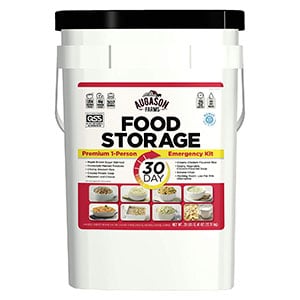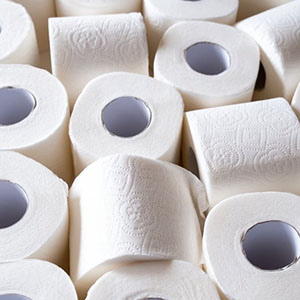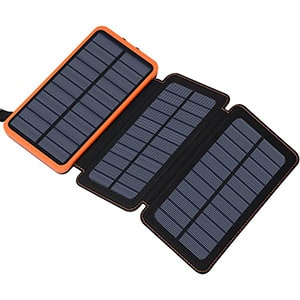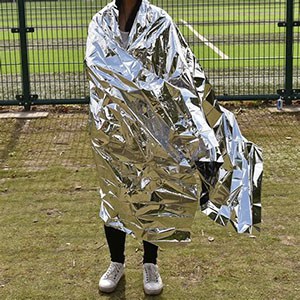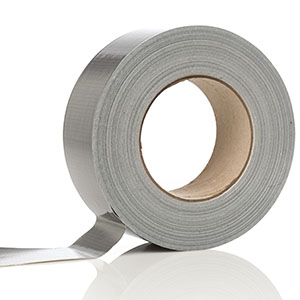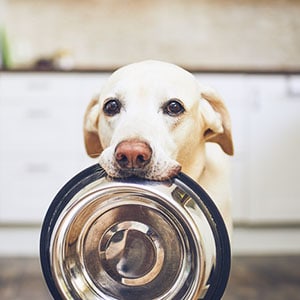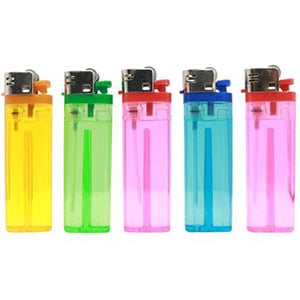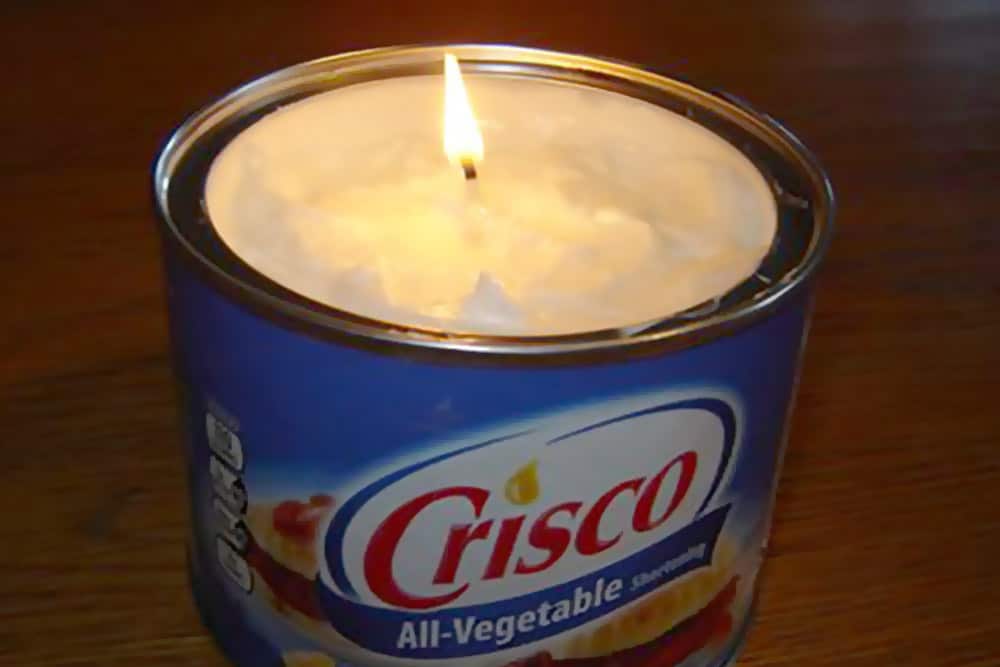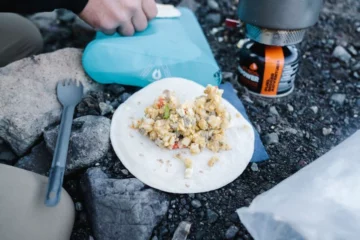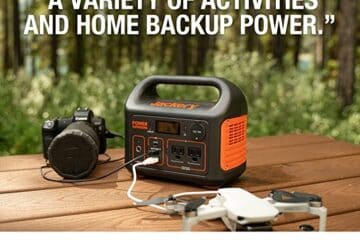In this day and age, we are faced with many challenges, including earthquakes, fires, and pandemics. We don’t have much control on the situations around us, but we do have control on how much we can prepare for these events. We can take matters in our own hands and depend on our own reserves.
So for all of those who want to start stockpiling supplies but don’t know where to start, we’re going to take a look at 15 items the Red Cross says the average person should have in their emergency stockpile.
1. Water

Humans can be pretty tough but we don’t last long without water. Because of this the Red Cross puts water at the top of their priority list when it comes to stockpiling things for use in an emergency. According to the CDC (1) you should plan on stockpiling a minimum of 1 gallon of water per day per person for at least 3 days.
If possible you should expand that stockpile to cover 2 weeks. That, of course, is predicated on the idea that you will remain stationary during that time. If you are forced to evacuate it will be crucial that you have water purification pills and/or water filters with you in case you are compelled to drink from questionable sources.
2. Food
We humans won’t last long if we don’t have water, nor can we go without food for very long. The Red Cross has food right up at the top of their priority list along with water because the two go hand-in-hand when it comes to maintaining overall wellbeing during an emergency (2).
As is the case with water, they suggest you store up to 2 weeks worth of food, and that you stockpile a variety of foods including dehydrated food, freeze-dried food, and canned food. Another easy way to store food is MRE’s. If there is someone in the house with specific dietary needs, such as a diabetic, remember to stockpile plenty of food specifically for them. If you want just flat out emergency food then you can make and store some hardtack.
3. Medications
If you or someone in your family requires regular prescription medication it’s vital that you stockpile some in case of emergency. How much will depend on the med and the person, but a 2 week minimum supply is suggested. Always follow the storage recommendations on the medication and toss and replace any meds that expire while sitting in your stockpile.
Keep in mind too that how much and how fast you can stockpile meds will depend on their classification. If a medicine is considered a controlled substance (3) by the DEA you will only be able to refill it at certain minimum intervals and a certain number of times. This could make stockpiling very difficult.
4. Batteries
For better or worse electricity changed the world and we have become almost completely dependent on it. So when an emergency strikes and the power goes out many people don’t know what to do. As long as you store enough batteries to run things like flashlights, headlamps and other devices you’ll have an easier time getting through to the other side of the emergency.
Of course, today many types of batteries are rechargeable and there are solar power banks as well that you can hook the chargers up to, so you don’t necessarily need as many batteries as you might have years ago. Just remember that if you’re storing one-and-done alkaline batteries that you make sure to replace them if they’re past the expiration date, or you could be in for a rude awakening.
5. Sanitation and Hygiene Items
No, we’re not talking about hoarding 5,000 rolls of toilet paper. But a couple of dozen rolls might be a good idea. Along with soap, shampoo, toothpaste, toothbrushes and anything else you depend on to stay reasonably fresh and clean.
Women should make sure to stockpile enough sanitary napkins to last them through at least 1 period. Being stranded without electricity and running water, or being holed up in a shelter is going to be hard enough. It will just be that much more unpleasant if you’re not able to maintain basic levels of hygiene.
6. Cash
Yup. Cash. Even the American Red Cross advises people to keep cash on hand just in case. If the power is out then ATMs are out and no one is processing credit cards. If a hurricane has devastated your area banks are closed. If things have broken down to the point that electronic commerce is simply not possible then having cash may wind up saving your bacon.
Whether it’s because of a hurricane or a civil unrest, when the SHTF your area may well revert to a cash only economy, at least for a while. So it’s important you have enough on hand to last at least 2 weeks to a month. That’s on hand, not in the bank. A lot of financial experts recommend stockpiling emergency cash in the bank. But if the bank is closed and you can’t access it, what good is that stockpile? Just make sure not to flash your cash around in front of others.
8. Power Banks
AA, AAA and D batteries used to be right at the top of the list of items to stockpile for an emergency. We have them at number 8, but they could be lower than that. Why? Because the most important battery operated item these days is the cell phone, which uses none of them.
It’s still a good idea to have some standard batteries on hand because some items still use them. But even more important is making sure you’ve got A) chargers for each of your cell phones and B) power banks to hook those chargers up to. Even better, make sure those power banks are solar powered so you’ll have power even when the grid goes down.
8. Emergency Blankets
There is no telling what form an emergency may take. You may wind up stranded in your home for days with emergency crews unable to reach you. That home may have no heat and a gaping hole in the roof. Or you may be forced to flee on foot. In which case you may wind up spending nights outdoors.
You can’t be carrying around heavy wool blankets with you, so what do you do? Emergency blankets, also known as “space” blankets (4), are super light and can make the difference between hypothermia and good health. Make sure you have lots of them on hand and you’ll be ready for just about any type of emergency.
9. Physical Maps
Let’s say there’s been a natural disaster and you have no way to recharge your phone. Or war has broken out and one of our favorite adversaries has crippled the GPS system (5). You need to bug out but you’re not sure where to go. So, what do you do? Why, you pull out your trusty map of course. There’s just one potential problem with that idea.
Map reading has become something of a lost art. People have become reliant on their phones, in concert with the GPS system, to read maps for them and tell them where they are, instead of looking at a map and figuring it out for themselves. So a refresher course on map reading (6) for everyone in the family might also be in order.
10. Face Masks
If the coronavirus did nothing else it pointed out how woefully unprepared most people were for a real emergency. 99% of people didn’t even have a standard face mask in their house that they could reach for when those items suddenly became mandatory pretty much everywhere on earth. What would have happened if there were a more serious biological threat floating around in the air?
The bottom line is that 2020 showed preppers were possibly the only people living with their eyes open. They had plenty of masks when everyone else was kicking each other in the shins to get the last few masks on the shelf at Walmart. Don’t let that kind of thing happen again. Take the advice of the Red Cross and stockpile face masks, because as 2020 proved, you never know.
11. Candles
A headlamp, a tactical flashlight or a cell phone with a flashlight component are all great things to have in an emergency. But at some point you’ll want to stop burning through your batteries. That’s where candles come in. They’re cheap and they’ll provide you with enough light to live by when the power goes out.
You should also consider stocking up on those gag candles that can’t be blown out. You know, the ones they put on your birthday cake that almost drove you nuts before you figured out what was going on. They don’t last long individually, but if you have enough of them they can provide you with hours of light in windy conditions.
12. Duct Tape
As the saying goes “If you can’t fix it with duct tape, you’re not using enough duct tape.” The route this tape, that was created to seal air ducts, took from the HVAC engineer’s toolbox to cultural touchstone is wrapped in gray, satin-finished mystery. But there is no denying that it’s one of those things that hold the contemporary world together.
Use it to patch clothes, repair your tent, make a splint, repair your boots, patch a hole in your water bottle or to attach your knife to a stick to make a spear. You can also use it to seal a crack in your windshield, hold your pants up, restrain the undead, or seal up around doors and windows in case of a chemical attack. Of course, you could use it to seal joints in your air ducts as well. But who does that?
13. Pet Food
When people start stockpiling emergency items they often forget about their pets. But if things go south in a hurry and you’re reduced to raiding the emergency stockpile to get by, then your dog or cat (or iguana or whatever) is going to be in the same boat as you. You can’t just kick ‘em to the curb and hope for the best.
Therefore, alongside the Spam, space blankets and face masks there should be plenty of food for your furry friend. If you have a month’s worth of supplies for yourself, there should be a month’s worth of food for your pet or pets.
14. Disposable Lighters and Waterproof Matches
There are more than a few anthropologists who believe that the harnessing of fire represents the turning point in human evolution (7). The ability to control fire gave us the ability to stay warm, see after nightfall, protect ourselves from predators, cook food and more. When stripped of modern conveniences we quickly discover that the ability to start a fire is still one of the keys to survival.
If you are an experienced outdoorsman you may already know how to start a fire with a flint and some birch bark. Most people, however, will need a less bush-crafty way of getting a fire going. And that’s where disposable lighters and waterproof matches come in. You simply can’t have enough of either one.
15. Copies of Important Documents
The Red Cross suggests you keep copies of your driver’s license, birth certificate (1 for each member of the family), passport, insurance coverage, car registration and other documents with your food, water and other supplies. These should be in a waterproof envelope so they’ll survive whatever comes your way.
The reason for having these is that, should a natural disaster leave your home in shambles, wash your car away and result in injuries that need to be professionally treated, you’re going to need some or all of this information to prove identity, prove coverage, and prove ownership of things. Also, keep copies of receipts for all valuable items in your home. These may come in handy later if you are filing a “proof of loss” (8) claim with your insurance company.
Other Important Items to Have
The above items should be gathered together in quantity. But there are other items that are equally important that you do not necessarily need 20 or 30 of. Here are a dozen or so other important items to have with your stockpile.
- A multi-tool (or two)
- A survival knife
- A well-stocked first aid kit
- A portable first aid kit in case you have to evacuate
- A hand-cranked radio (NOAA weather radio)
- An emergency whistle or two
- Heavy duty work gloves
- A handgun and ammo
- Heavy duty scissors
- Board games
- A fully stocked bug out bag
The above is not a comprehensive list by any means, but the bug out bag is particularly important. That’s because there is no guarantee you will be able to stay in your home. What if the emergency is weather-related and you’re forced to evacuate? Essentially you should have a compact version of your stockpile in a bug out bag ready to just grab and go.
Why Should You Bother Stockpiling Anything?
In spite of the unprecedented events of the past year, there are still plenty of skeptics out there who don’t see the point of stockpiling anything.
But being prepared is not the same as being unstable. In fact, it’s just the opposite. So here are some good reasons you should take the advice of the Red Cross and consider stockpiling items.
Stockpiling is not a new idea – In fact, it’s likely your great grandparents and their parents and their parents etc, etc, stockpiled food. In the 19th and early 20th century canning (9) was a common way to preserve fruits and vegetables for future use and a high percentage of American households had a store of such foods. Those folks weren’t crazy. They were smart, tougher than most of us, and prepared.
Stockpiling provides peace of mind – Did you see what was going on in supermarkets and big box stores in early 2020? Millions of people suddenly realized they weren’t in any way prepared for the worst, and they panicked. But that doesn’t have to be you. If you have a well-considered stockpile of useful items you’ll be able to rest easy, knowing that next time around (and don’t kid yourself, there will be a next time) you’ll be ready.
Stockpiling tells loved ones that you care – While kids (especially teenagers) may be dismissive of stockpiling you can be certain that somewhere in a seldom accessed corner of their brain they’re taking a bit of comfort in knowing that stockpile of yours is there. They’re also quietly taking note that you care enough about them to prepare for the worst. And to some degree it’s helping them sleep a little easier too.
Stockpiling helps you appreciate what really matters – In a world of instant global communication, unparalleled opportunities and incredible uncertainty it can be difficult to stay grounded. The process of determining what to stockpile and then collecting, storing and maintaining that stockpile is bound to give you pause to consider what really matters. That knowledge will help you keep your feet on the ground when the lights go out and you’re suddenly back in the 19th century.
Your stockpile may say your life – No one saw the coronavirus coming (except maybe preppers). And while it produced a year like no other, the fact is there are many much, much worse things that could, and very well may, happen at some future date. When they do, your stockpile may wind up, not just providing peace of mind, but actually saving your life and the lives of your loved ones. That possibility alone is justification enough to start stockpiling.
When you stockpile you are part of the solution, not the problem – Every time someone busts into a store in a panic to secure vital supplies they only make an already bad situation even worse. If they had spent some time preparing for the unexpected they wouldn’t be out there victimizing some shop owner and making the recovery, when it happens, that much harder.
Stockpiling teaches self-reliance – The process of creating and maintaining a viable stockpile inevitably enhances a person’s sense of self-reliance. And that is a very good thing. The concept of self-reliance is often frowned upon these days, but it shouldn’t be. A self-reliant person is someone who will not be a burden to others when things get rough. A self-reliant person is one who accepts responsibility for his or her life, and his or her actions. And people who know and trust themselves are typically good people to have in your corner.
Conclusion
The Red Cross is not the only well-known organization that urges people to stockpile materials for emergency use. FEMA, the CDC as well as state and local governments all understand how important it is that people are ready to face the unexpected. Preparedness is what separates the calm from the chaotic, the self-contained from the out-of-control, and the dependable from the dependant.
So remember, a willingness to stockpile food, water and other essential items does not mean you’ve joined the tin foil hat crowd. Instead, it’s part of a long tradition and a surefire sign that you have both feet planted firmly in the real world.
